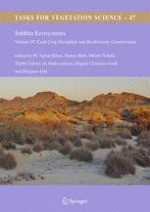
2014 | OriginalPaper | Buchkapitel
Spatial Distribution of Soil Salinity and Management Aspects in the Northern United Arab Emirates
verfasst von : Mahmoud A. Abdelfattah, Shabbir A. Shahid
Erschienen in: Sabkha Ecosystems
Verlag: Springer Netherlands
Aktivieren Sie unsere intelligente Suche, um passende Fachinhalte oder Patente zu finden.
Wählen Sie Textabschnitte aus um mit Künstlicher Intelligenz passenden Patente zu finden. powered by
Markieren Sie Textabschnitte, um KI-gestützt weitere passende Inhalte zu finden. powered by